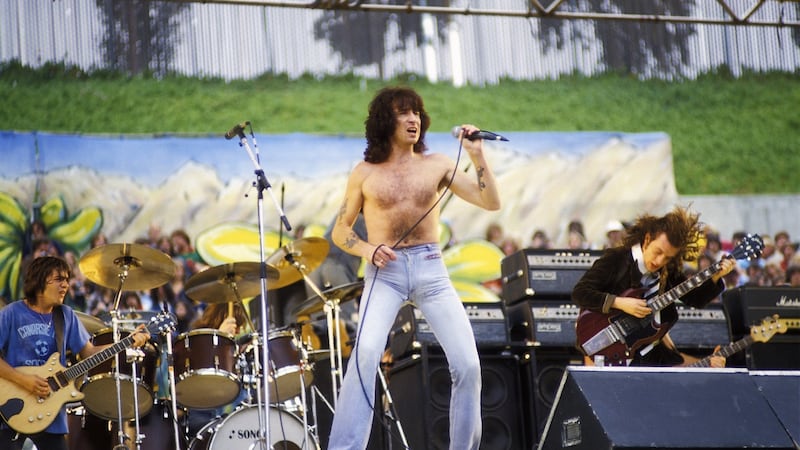The death of Malcolm Young last month from dementia surely brings to an end to AC/DC – one of the greatest and most successful rock bands in history.
The band's former singer Bon Scott occupies a unique place in AC/DC mythology. He died, aged 33, in 1980, the same year the band released the album, Back in Black, one of the biggest-selling albums in music history.
Scott is the internal larrikin in the AC/DC story, a street poet whose arch observations and clever puns were the perfect accompaniment to the band’s inspired riffs.

AC/DC went on to be global superstars after Scott died and yet many fans feel he personified the soul of the band in a way his more successful replacement Brian Johnson never did.
Jesse Fink's biography Bon – The Last Highway is a follow-up to his 2013 book The Youngs: The Brothers Who Built AC/DC.
The Youngs was a valiant attempt to break the omerta around this notoriously secretive band.
The book is not a flattering portrait of the Young brothers, Malcolm, Angus or George, the producer who died last month. They come across as controlling and ungrateful, but at least Fink takes them seriously – something music critics have consistently failed to do throughout AC/DC’s long career.
Bon – The Last Highway is not a conventional biography. It focuses on Scott's last three years between 1977 and 1980. It is a portrait of a troubled man with a serious alcohol addiction. Scott is unmoored from his surroundings. He has not seen his parents in three years.
He expresses a desire to leave the band, settle down and get married, but always the elusive pay day which would allow him the latitude to make these choices remains tantalisingly out of reach.
Once again past and present members of the band declined to co-operate with the book and once again Fink had managed to circumvent their opposition by his diligent research.
His book is the literary equivalent of a road movie. He roams across the United States, interviewing those ex-girlfriends and friends who provided the type of companionship Scott does not appear to have got from his own band.
AC/DC appear like shadows in this book. It is clear that while Scott was consumed with the band’s unending schedule, his real life was happening elsewhere.
The most interesting encounter in the book is Fink’s meeting with a woman he identifies only as Holly X, a recovered alcoholic living in Florida. She was 20 when she met Scott and the pair were lovers.
Fink makes a compelling case that the lyrics of You Shook Me All Night Long, a standard in AC/DC's repertoire from the Back in Black album, were written by Scott and not by the Young brothers and Brian Johnson.
Fink addresses at length the notion that the lyrics in Back in Black were written wholly or partially by Scott. The conventional wisdom is that the lyrics were simply too clever to be written by anyone else.
AC/DC fans will recognise a lot of truth in that, but Fink advances no hard evidence that the lyrics in Back in Black, with the exception of You Shook Me All Night Long, were written by Scott.
The author devotes nearly 140 pages to the circumstances behind Scott’s death on February 19th, 1980 in Overhill Road, Dulwich, south London.
He has done a prodigious amount of research, but this section of the book needed editing. The length he goes to explain the different accounts of what happened would be appropriate if Scott, for instance, had died by foul play, but this is not suggested here.
Fortunately, Fink has synthesised his research into two theories – both involve Scott (spoiler alert) dying from a heroin overdose or a combination of heroin and alcohol.
Iron Maiden
While Scott was a victim of rock and roll excess, Iron Maiden lead singer Bruce Dickinson is a great survivor.
What Does This Button Do? – his self-written autobiography (he eschewed a ghostwriter and wrote it all himself in longhand) – is a rollicking account of being in one of the great heavy metal bands.
Dickinson writes well particularly about his unorthodox childhood in the English midlands. For the first five years, he was brought up by his grandparents as his teenage parents, Bruce and Sonia, toured Britain with a performing dog act. “I now realise there wasn’t a great deal of affection going on, but there was a reasonable attention to detail. I could have done a lot worse given the circumstances.”
There is not a scintilla of self-pity in this book. Dickinson keeps the same jaunty tone whether he is talking about his parents’ long absences or being diagnosed with head and neck cancer in 2014, a life-threatening and career-threatening illness for the singer.
There are no great emotional insights in this book nor is he given to bouts of gloomy introspection. Dickinson makes it clear his private life, particularly his wives and children, are off limits. He writes, though, at length about his outside interests, especially fencing (he represented Britain internationally) and gaining a commercial pilot’s licence. These are the “small hidden worlds” as he puts it which keep him sane. “The music business will drive you nuts if you let it.”
There are useful insights into the secrets of Maiden's longevity and continuing brilliance – their last album, The Book of Souls, is one of the best of their long career. The band, he suggests, is a "guided autocracy" involving a triumvirate of him, the bass player and founder, Steve Harris, and long-time manager Ron Smallwood. The reader is in no doubt that the driving force behind the band is Harris. There is an amusing anecdote at how Dickinson and Harris vied with each other for prominence on stage in the beginning and clashed like two rutting stags after one concert in Newcastle, but generally they appear to rub well enough together as men and musicians.
Queen
Queen guitarist Brian May is another of rock’s renaissance men. This doctor of astrophysics is also a keen photographer. During Queen’s heyday as one of the biggest bands on the planet in the 1970s, May brought along a stereoscopic camera.
The best photographs are compiled in the book which is the first ever authored by a member of the band. He also designed the Owl viewer that goes with it which brings these stereoscopic images to life. This will make a great Christmas present for Queen fans.
'Bon: the Last Highway' by Jesse Fink is published by Black & White Publishing priced €19.99.
'What Does This Button Do?' by Bruce Dickinson, published by Harper Collins is priced €16.99 in paperback.
'Queen in 3-D' by Brian May is published by the London Stereoscopic Company priced €60




















